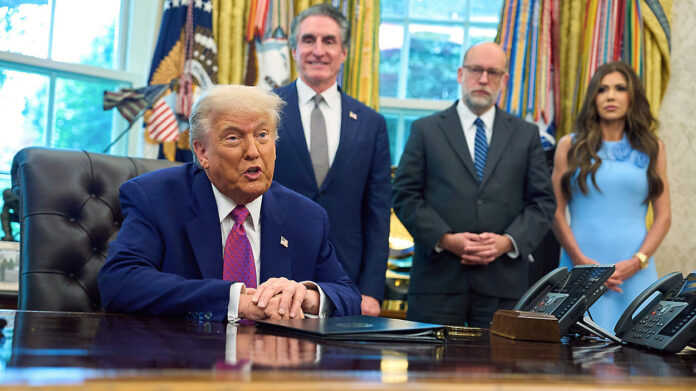The key phrase FEMA has returned to national headlines in a major way as former President Donald Trump pushes for a dramatic transformation of America’s emergency response structure. In a recent statement, Trump confirmed his intention to phase out FEMA’s current role after the 2025 hurricane season, shifting disaster authority directly to state governors. This controversial move has sparked nationwide debates about federal responsibility, state preparedness, and what this overhaul could mean for future emergencies.
The plan is being rolled out as the U.S. braces for a particularly intense storm season. Trump has argued that governors should manage disaster recovery independently, stating that if they can’t handle it, they “shouldn’t be governor.” As a result, FEMA’s operational strategy is undergoing massive changes, and thousands of jobs at the agency are reportedly at risk.
Trump’s FEMA Phase-Out Strategy: A Closer Look
Under Trump’s new strategy, FEMA’s traditional disaster response duties are being dramatically reduced. Instead of the federal agency leading recovery efforts, funds and logistics support will now be distributed from the Department of Homeland Security or the Executive Office itself.
Key elements of Trump’s FEMA overhaul include:
- Staff reductions: Thousands of FEMA jobs are being cut as part of a broader downsizing.
- Disaster grants reform: Local governments are being told to work directly with state officials, bypassing the agency.
- Review council implementation: A new advisory panel is developing guidelines to permanently reduce FEMA’s footprint.
The ultimate goal appears to be a reallocation of FEMA’s core responsibilities, with a focus on empowering states to take full ownership of emergency response.
Local Emergency Managers Voice Concerns Over FEMA Cuts
State and local emergency officials have begun adjusting their planning strategies to reflect a FEMA-less future. In some regions, officials are preparing for storm season with limited federal support. Emergency coordinators in coastal states like Florida and Louisiana have said publicly that they are “preparing as if FEMA won’t show up.”
The ripple effects of this transition are already being felt:
- Disaster shelters are scaling back expectations for federal assistance.
- Emergency supply chains are being restructured through state-level vendors.
- Nonprofits are bracing for increased demand without FEMA coordination.
This shift in responsibility, while supported by some states with strong infrastructure, is putting stress on those that rely heavily on FEMA’s logistical capabilities and federal funding.
FEMA’s Leadership in Flux Amid Political Realignment
Another major headline in the FEMA overhaul is the internal reshuffling of leadership. Earlier this spring, the acting FEMA Administrator was unexpectedly removed just days after expressing concerns about dismantling the agency’s role. His replacement, a former DHS official with limited disaster-response experience, is currently managing the agency under immense pressure.
Reports from within FEMA suggest that:
- Many regional offices are operating with reduced capacity.
- Training programs for disaster personnel have been postponed or canceled.
- Morale within the agency is at an all-time low due to uncertainty over its future.
Despite these challenges, the new leadership claims they are implementing a modernized vision of FEMA that is leaner, faster, and more “state-focused.”
The question on everyone’s mind is simple: can states truly handle what FEMA has historically managed? While some governors support the change, arguing for greater autonomy and reduced federal oversight, others fear their state budgets and personnel are not ready to take on the full burden of disaster relief.
Challenges ahead include:
- Complex coordination during multi-state disasters like hurricanes or wildfires.
- Funding shortfalls, especially in economically struggling states.
- Lack of expertise, as FEMA’s personnel are among the most trained in emergency management globally.
Nonprofits and local agencies are stepping up, with organizations like the Red Cross, Team Rubicon, and other volunteer groups increasing their presence. However, many warn that even their combined efforts may not fully replace what FEMA provides during major emergencies.
What Americans Can Expect in 2025 and Beyond
With hurricane forecasts predicting an above-average season, many are asking what safety nets remain in place. Trump’s plan to cut back FEMA’s role is not just a policy shift—it’s a fundamental change to how America handles natural disasters.
The next six months will be critical as:
- FEMA prepares to enter hurricane season with less staff and fewer resources.
- States finalize their emergency protocols.
- Citizens face growing uncertainty about who will show up when disaster strikes.
This FEMA overhaul could redefine disaster response for decades. Whether it improves local accountability or leaves vulnerable communities exposed will depend on how well state and local governments rise to the occasion.
If you live in a disaster-prone area, now is the time to act. Connect with local emergency offices, prepare evacuation plans, and stay informed about changes in disaster aid. The future of emergency response is shifting—and preparation is more important than ever.
